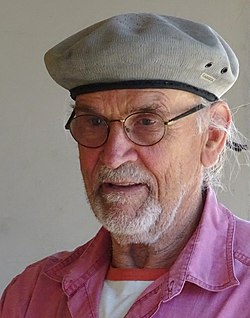
The term sandcasted glass has come to to be inextricably linked with Bertil Vallien. He took up and developed this originally industrial technique (used, for example, in metal casting), and continues to explore its possibilities which are by no means exhausted. Each new technical advance widens and enhances the artistic range, generating countless cycles of themes and motifs. It began with his discovery of the light-absorbing property of glass in the 1960s-70s continued with the metaphysical boats (filled with universal tokens); through the torsos and monoliths to the thin glass slabs resembling runic stones, or prehistorical maps, indicating archaeological finds, infused within the congealed glass. An ongoing development of new casting techniques provides the basis, or starting point for a variety of sculptural forms.
Since 1963, he has been associated with the Åfors glass-factory, where he has continued to pursue and develop his creative work. He was also responsible for the reorganisation and updating of working procedures , and for expanding the role of the artisans. All this has meant that Åfors, once condemned as obsolete, is now a flourishing glass manufactory, where the main emphasis is on artistic skill. As a designer, during the 1970s and 80s, Vallien created a long line of classic glass services, which are in production still today.
During the 1990s, Bertil Vallien sought to simplify his forms, cognisant of the obligation that the beauty of glass imposes. Remarkably, this potentially dazzling substance is a hindrance to his artistic resolution; but instead of reverting to stone, or any other unyielding medium, he has sought to tame the glass. His gleeful (much quoted) utterance from the early 1980s, “glass eats light”, has been a guiding principle in all his artistic endeavour ever since.
In the search for synthesis between light and form, the human head was a perfect medium for realising those intentions. The light-absorbing glass also acts as a skin or membrane, allowing vision into the spaces within. In the head, he has created his own particular spaces – rooms for thought, wherein the mystical light conveys and abstracted, transcendental quality; or where the infusion of a face may suggest thoughts and reflection about others. It is a quest for the unearthly light – ethereal, and ever elusive.
Bertil Vallien is one of the few innovators of glass art in the world today. Along with a small number of other artists, he has broken new ground and his work has been particularly well received in the USA, where he exhibits and lectures at the universities on a regular basis; but also in Japan and Australia.
For information on more available work from this artist, please contact us.